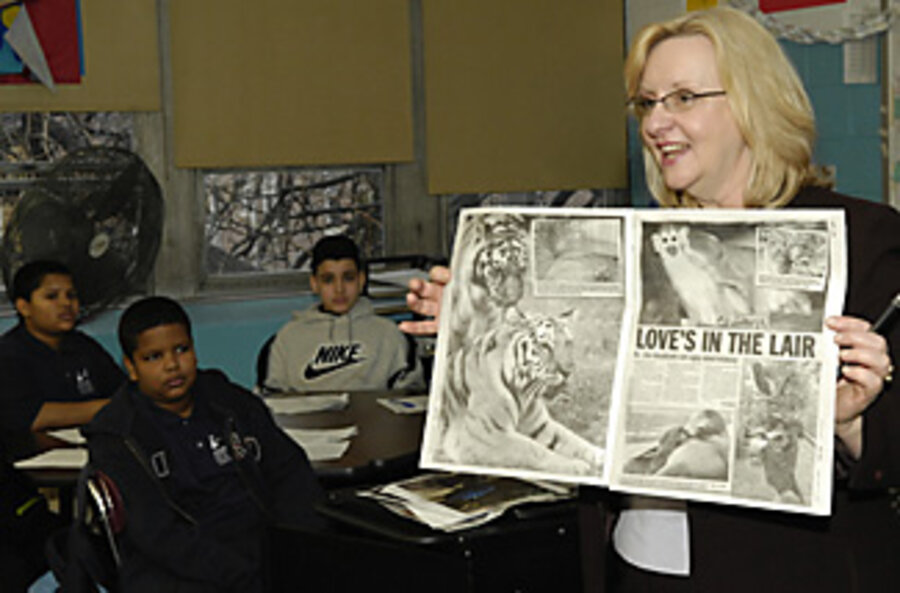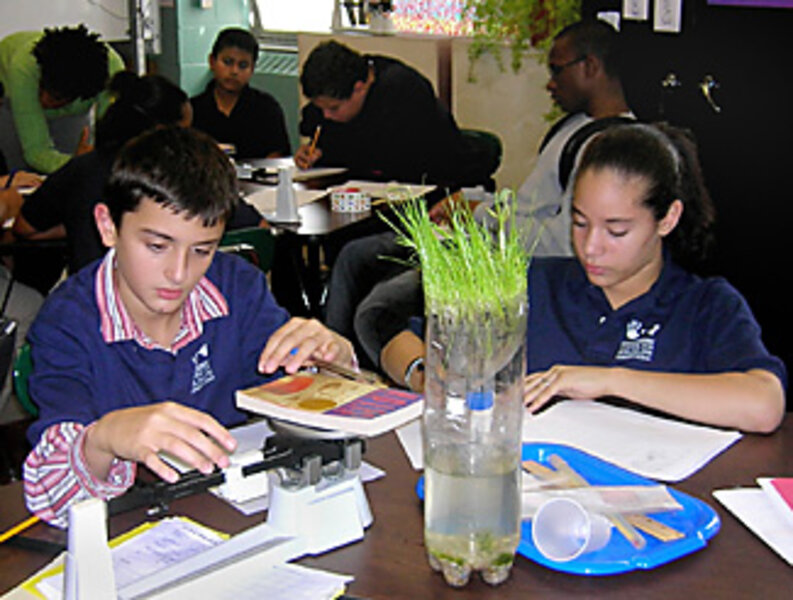In the Bronx, a class with conservation at its core
Loading...
| New York
When Elijah Maderon attended a class at the Bronx Zoo in January, he and his fellow sixth-graders gave presentations on how they might protect peregrine falcons from the pesticide DDT if they were conservationists on a tight budget.
Inspired by the activity, Elijah quickly prepared a proposal afterward. With the silver tongue of an experienced entrepreneur, he described a video game to an intrigued teacher. Called Zoo Tycoon, the game allows players to work within a budget to build and maintain a zoo with the goals of ensuring its animals' health and happiness while still turning a profit. The game, Elijah maintained, would fit right in with his school's curriculum.
That kind of thinking is encouraged at the Urban Assembly School for Wildlife Conservation (UASWC) in the Bronx, where Elijah and 148 other students represent the inaugural class. This is one of 19 themed-curricula public schools throughout New York City funded partly by a grant from the Bill & Melinda Gates Foundation.
At UASWC, wildlife conservation is integrated throughout core subject areas. Through partnerships with organizations including the Wildlife Conservation Society and its flagship institution, the Bronx Zoo, students are given access to resources and professionals in the wildlife-conservation field beyond the reach of most graduate schools.
With plant and animal species becoming endangered or extinct at an alarming rate, and increasing pressure to address global warming, the United States needs science and wildlife conservation specialists. At the same time, middle school science proficiency scores have plateaued, with overall scores at the high school level declining since 1996, according to the National Center for Education Statistics.
"There is real concern that there may not be enough kids coming through schools in the US to meet our needs in science and math 15 years from now," says James Hennessy, dean of the Graduate School of Education at Fordham University in New York City.
Mark Ossenheimer, principal of UASWC, hopes his school – which will also serve as a high school in coming years – has set out to address this problem. "We aim to create generations of urban ecologists," he says. "Even if they do not enter into a science field, they will be well versed in the relevant issues and systems of conservation science."
UASWC meets government education standards while also engaging students through the allure of the natural world. The sixth-grade Wildlife Conservation class, for example, is essentially an ecology course. Subsequent classes will focus on topics such as animal behavior and zoo-exhibit design.
For the current class, math takes on new relevance through a "waste audit," as students calculate their environmental footprint over the course of a year and then work to reduce it.
Besides going to the zoo, the class makes frequent trips to nearby beaches, wetlands, and reservoirs. There, students learn about the biomes of New York, working closely with conservation professionals on experiments ranging from measuring water turbidity to monitoring the effects of human development on local biodiversity.
"We are quickly instilling the fact that these are not just field trips, but an extension of the classroom," says Mr. Ossenheimer.
Beyond exciting kids about science, UASWC wants to foster a sense of responsibility to the community – and a commitment to sustainable living.
"It's easy to forget that we live in the midst of a temperate forest. Introducing them to the native trees and wildlife here inspires stewardship," says Lily Ng, partnership coordinator for UASWC. "The Bronx River flows just a few blocks from this school and is quickly becoming just as important a feature in their lives as their grandmas' houses and the playground."
Several youths volunteer with the nonprofit Bronx River Alliance (BRA), making maps of the river terrain and attending cleanup events. Parents are invited to spend a few weekend hours at the Bronx Zoo, participating in Project SPARKS, a science-education program that stands for Supporting Parents in Advocacy, Reform and Knowledge in Science.
"Parents come [to SPARKS] really excited," says Ilyssa Gillman, manager of program development and instruction at the Bronx Zoo. "Science is one of those topics perceived as scary sometimes, so it's important to make it accessible to them as well."
Winning over kids raised on television can demand some creative gusto, resulting in activities like "Teen Iron Chef." The after-school cooking class shows kids how to cook healthy, fresh meals and shop at a farmers' market. Students also grow vegetables at nearby Drew Community Garden, a former vehicle junkyard restored with healthy soil.
Recruiting solely from within the Bronx, UASWC is well positioned to provide valuable skills to minority children, who are among the least likely to later earn degrees in engineering, math, and science. Although the school is too new to conclusively show any academic gains, an impressive 95 percent attendance rate puts UASWC ahead of the pack in a city with high truancy rates.
A career fair held at UASWC earlier this month introduced sixth graders to professionals from local government agencies to global conservation groups.
"Kids meet someone with a fascinating job and say, 'when I grow up I want to be like them.' The younger that happens, the earlier they will begin planning to receive an education that will make that aspiration a reality," says Ms. Ng.
In the meantime, students keep on learning as the curriculum continues to evolve.
"We are trying everything out on them," says Erin Prada, a Wildlife Conservation teacher. "But they're still going to have a much better experience here than at any other New York school that they could probably go to, and still come out with a competitive edge."







